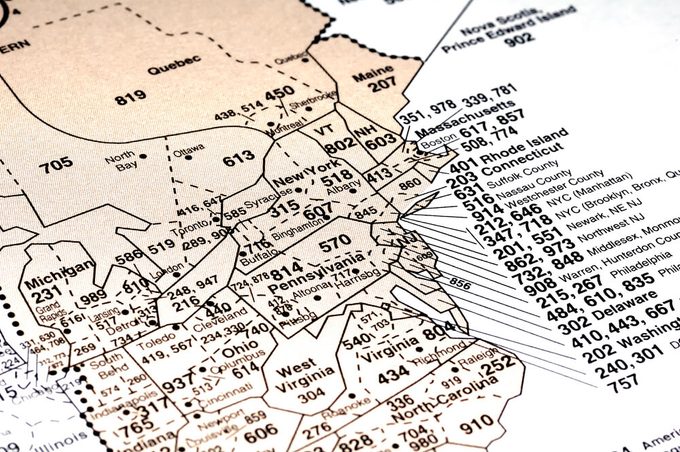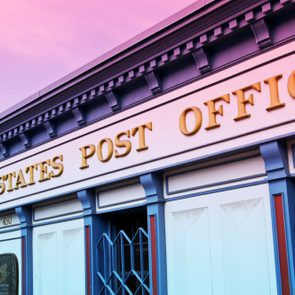Geography was the last thing the telephone company was thinking about when they developed the area code system

Here’s the Real Reason Area Codes Make No Geographical Sense

Have you ever noticed how area codes aren’t laid out as neatly numerically as, say, the U.S. Interstate Highway system? For the most part, interstate highway numbers tend to grow higher in value as you travel east or south, but if you move from New York to Vermont, your area code may change from 518 to 802. Your next-door neighbor might even have a completely different area code. That might make you wonder: When did area codes start, anyway?
But the bigger question is: Were they always so random? We wanted to get to the bottom of this mystery, so we dug deep into those three all-important numbers. Read on to learn why area codes have a logic all their own.
Get Reader’s Digest’s Read Up newsletter for more geography, humor, cleaning, travel, tech and fun facts all week long.
When did area codes start, and why?
The Bell System, formerly a system of companies led by the Bell Telephone Company, created the first area codes back in the 1940s. It was called the North American Numbering Plan.
These designated area codes helped automate phone calls to anywhere across the country without the use of a human operator to connect calls. There weren’t enough human operators to fulfill the needs of the expanding population, so the three-digit codes helped streamline the process.
So why are area codes so random?
To understand the arbitrary jumps in numbers, you need to know one key fact: Geography didn’t originally determine area code designations—population density did. It all started when area codes were first launched, back when the United States was way less populated than it is today.
To start, most states had one area code
When area codes started, the Bell System designated 86 separate Numbering Plan Areas throughout North America. By 1947, the majority of the states had one area code, with a select few, such as California, getting more due to the state’s size and population. Each state area code got either a “0” or a “1” for its second digit. States with single area codes got a “0,” and states with multiple area codes got a “1.”
By leaving out numbers higher than “1” for the second digit, the company ensured that plenty of other area codes would be available in the future to compensate for population growth.
Which states and cities got the “best” area codes?
States with the densest populations and prominent cities scored the most popular codes. In other words, they got the ones that were easiest to use on the cutting-edge tech of the day: an analog dial phone. For example, California initially claimed area codes 916, 415 and 213, while the city of Chicago got 312.
Of course, there are other quirks to the phone system, including the fact that special number combinations like 37X and 96X have been set aside (reportedly in case they’re ever needed for emergency purposes).
Most states now have more than one area code
Today, if you look at a map of area codes in the U.S., the North American Numbering Plan isn’t as clean and simple as it once was. For the most part, an area code no longer covers one whole state, but instead a region within the state.
The more populous a state, of course, the more area codes it has. California has the most area codes, while states like South Dakota and Alaska have only one area code each.
How area codes became more random
Our booming population isn’t the only thing to blame for the expanding number of area codes—technology is too. As people started communicating via many devices, including faxes, pagers, modems and cell phones, there weren’t enough available area code combinations. Simply put, a single area code just wasn’t enough to satisfy the number of people and tech devices.
Why are phone numbers now 10 digits?
You might remember a time when you only had to dial seven digits to call your next-door neighbor—or anyone in your zip code. Now, you always have to dial an area code. In 1997, Maryland had to switch to 10-digit numbers for local calls, and cities like New York City have had multiple area codes for many years. On October 24, 2021, the Federal Communications Commission (FCC) made 10-digit dialing mandatory everywhere. The reason we have to dial 10 digits every time is because many local regions across the country have more than one area code.
Will area codes always be this random?
When these special codes first launched, there was a lot more strategy and logic behind the assignment process. But today, the main reason one area code is used over another is just that it’s available. Bottom line: As long as our calls and texts keep going through, that’s really all that matters.
Why trust us
At Reader’s Digest, we’re committed to producing high-quality content by writers with expertise and experience in their field in consultation with relevant, qualified experts. We rely on reputable primary sources, including government and professional organizations and academic institutions as well as our writers’ personal experiences where appropriate. We verify all facts and data, back them with credible sourcing and revisit them over time to ensure they remain accurate and up to date. Read more about our team, our contributors and our editorial policies.
Sources:
- LincMad: “Telephone Area Codes”
- World Atlas: “US Area Codes by State”
- Atlas Obscura: “The Unexpected Logic Behind Area Codes”
- FCC: “Ten-Digit Dialing”






















